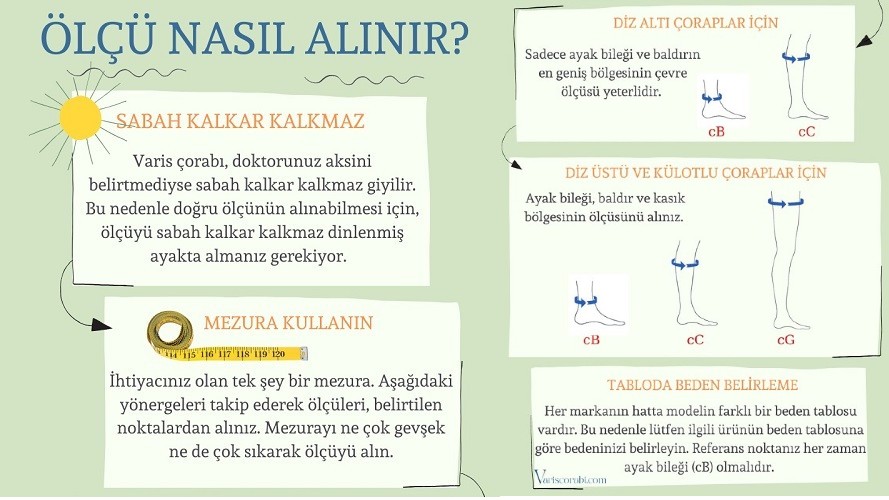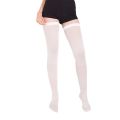Açıklama
Varimed® Anti Emboli Çorapları “TS ENV 12719 Tıbbi Tromboz Profilaksi Çorabı” standardına uygun olarak hastaya en yüksek konfor ve faydayı sağlayacak şekilde tasarlanmıştır. Diz altı, uyluk boyu ve belden kemerli tiplerde üretilen çoraplar, geniş bir ölçüm aralığını kapsayacak ölçü sistemine sahiptir. Ayrıca kolay ayırımı sağlamak için her bedenin topuk bölgesine ayrı bir renk verilmiştir. Çoraplar parmak altında kan dolaşımının kontrolünü sağlayan bir kontrol deliğine sahiptir. Uyluk boyu tipinde çorabın bacaktan kaymasını engelleyen ve basınç profilini bozmayan damla silikonlu elastik bant mevcuttur. Belden kemerli tipinde ise bacağı rahatsız etmeyen mükemmel esneklik ve yumuşaklığa sahip şeffaf iç dikiş lastiği ve belinize göre rahatlıkla ayarlanabilen elastik bel kemeri kullanılmıştır. Üretimde tamamen Öko-Tex 100 sertifikalı malzemeler kullanılarak çorabın giyilmesi sırasında ciltte oluşabilecek alerjik etkiler minimum düzeye indirilmiştir. Varimed® Anti Emboli Çorabındaki basınç, ayak bileğinde maksimumdur ve bu basınç bilekten uyluğa doğru dereceli olarak azalan bir basınç profili çizer.
Kullanım Alanları
· İmmobil hastalarda derin toplardamar kan pıhtılaşmasına karşı korur.
· Dereceli baskı sağlayarak kan akış hızını artırır.
· Kronik toplardamar stazı gibi diğer toplardamar bozukluklarında kan akışını artırır.
Kontrendikasyonlar
· Çorabın ağırlaştırabileceği bölgesel bacak durumları;
1. Selülit,
2. Deri iltihabı,
3. Gangren,
4. Fasit,
5. Yakın zamanda yapılmış deri grafiti,
6. Panikülit,
· Ciddi damar sertliği ya da diğer iskemik damar hastalığı,
· Bacaklarda ağır ödem ya da konjestif kalp hastalığı nedeniyle akciğer ödemi,
· Bacakta aşırı ölçüde biçim bozukluğu
Derin Damar Trombozunun Önlenmesinde Kompresyon Tedavisi
Derin damar trombozu derin damarlardaki kanın pıhtılaşmasıdır.
Kan damarlarındaki pıhtıya tromboz denir. Tromboz hem yüzeyel hem derin bacak damarlarında oluşmasına karşın, derin damarlarda oluşan tromboz asıl tehlikeli olandır. Tehlikeli olmasının nedeni trombüsün tamamı ya da kopan bir kısmının, kan akımına karışarak akciğere giden arteri tıkaması ve kan akışına mani olmasıdır. Hareket eden tromboza embolus adı verilir. Derin damar trombozu varislerin flebitiyle karıştırılmamalıdır. Flebit ağrılı fakat nispeten zararsızdır.
Üç faktör derin damar trombozuna neden olabilir: Birincisi; damar duvarı hasarı, ikincisi; kanın pıhtılaşmaya olan eğiliminin artması ki buna yol açan durumlar arasında bazı kanser türleri ve nadir olarak oral kontraseptif kullanımı yer alır ve üçüncü olarak; damar içinde kan akımının yavaşlamasıdır. Bu durum uzamış yatak istirahatinde görülebilir çünkü baldır kasları kasılmayacak ve kanın kalbe doğru akımını sağlayamayacaktır. Örnek olarak, kalp krizi sonrasında günlerce hastanede yatan ve çok az bacak egzersizi yapabilen hastalar ya da uzun dönem boyunca oturmak zorunda olan ve kasları fonksiyon görmeyen parablejik hastalarda meydana gelebilir. Travma veya büyük ameliyatlar da pıhtılaşmaya eğilimi artırabilir. Uzun mesafeli araç veya uçak yolculukları yapmak durumunda olan ve hareketsiz kalan sağlıklı bireylerde dahi görülür.
Derin damar trombozu olan insanların yarısında tam olarak belirti görülmemektedir. Bu insanlarda akciğer embolisine bağlı göğüs hastalığı ilk belirti olabilir. Derin damar trombozuz inflamasyon ve kan akımının obstruksiyonuna neden olduğunda baldır şişer ve ağrılı olabilir, dokunulduğunda hassas ve sıcak olabilir. Tutulan vene bağlı olarak bilek, ayak ve uylukta şişer.
Bazı trombüsler iyileşirken skar dokulara dönüştürülür ve bu durum damarlarda bulunan kapakçıklara zarar verebilir. Sıvı birikmesi sonucu bilekte şişkinlik olabilir. Tutulan damar boyutuna bağlı olarak tıkanıklık ciddi derecede yukarı geldiyse ödem bacağa yayılabilir ve uylukta da meydana gelebilir. Ödemler gün içinde oturmaya ya da ayakta kalmaya bağlı olarak yerçekimi etkisiyle gün sonuna doğru daha da kötüleşir. Gece boyunca bacaklar yatay pozisyonda olduğu için damarlar kolaylıkla boşalır ve ödem azalır. Derin damar trombozu riski tamamen ortadan kaldırılamamasına rağmen bazı yollarla azaltılabilir.
Bu yollardan bir tanesi anti emboli çorap giymektir. Anti emboli çorapları bacaklara devamlı basınç uygularak kan akışını hızlandırır ve pıhtılaşmayı azaltır. Anti emboli çorapları, ayak bileğinde en yüksek, baldır ve uyluğa doğru azalan bir dış basınç uygular. Böylece derin damar sisteminde kan akışkanlığını artırır.
Özellikler
Beden Tablosu
| Çevresi (cm) | XSmall | Small | Medium | Large | XLarge | XXLarge | |
|---|---|---|---|---|---|---|---|
| cG | 47 - 56 | 52 - 61 | 56 - 65 | 61 - 71 | 66 - 76 | 60 - 68 | |
| cC | 29 - 36 | 33 - 40 | 35 - 42 | 38 - 45 | 42 - 49 | 39 - 49 | |
| cB | 18 - 20 | 20 - 23 | 23 - 26 | 26 - 29 | 29 - 32 | 32 - 35 | |
| Referans noktası her zaman ayak bileğidir (cB). Ölçüm yapmaya ayak bileğinden başlayınız. Beden tablosunda ilk önce (cB) bölgesini dikkate alınız. | |||||||
| Uzunluk (cm) | Kısa | Normal |
|---|---|---|
| lG (Külotlu, Diz Üstü) | 65 - 74 | 75 - 84 |
| Yerden kasığa kadar olan bölgenin uzunluğunu ölçünüz. Ölçüyü bacağın iç kısmından almanız işlemi kolaylaştıracaktır. | ||
Beden Ölçüsü Nasıl Alınır

Değerlelendirmeler
Yorum bulunamadı



 Google ile giriş yap
Google ile giriş yap

